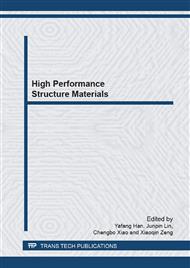[1]
Guo-Zheng Quan, Tae-Wan Ku, Woo-Jin Song, Beom-Soo Kang. The workability evaluation of wrought AZ80 magnesium alloy in hot compression. Materials and Design. 32 (2011).
DOI: 10.1016/j.matdes.2010.11.025
Google Scholar
[2]
Barnett MR. Influence of deformation conditions and texture on the high temperature flow stress of magnesium AZ31. J Light Met . 1(3) (2001)167–177.
DOI: 10.1016/s1471-5317(01)00010-4
Google Scholar
[3]
Wu Yujuan, Ding Wenjiang, Peng Limin. Research progress of advanced magnesium rare-earth alloys. Materials China. 2(2011)1-10.
Google Scholar
[4]
Gao X, et al. Microstructure evolution in a Mg-15Gd-0. 5Zr (wt. %) alloy during isothermal aging at 250℃. Material science and engineering A. 431(2006)322-327.
DOI: 10.1016/j.msea.2006.06.018
Google Scholar
[5]
LIANG Min-jie, et al. Effect of inclusion on service properties of GW103K magnesium alloy. ScienceDirect. 21( 2011) 717-724.
Google Scholar
[6]
Li Hui-zhong, et al. Constitutive equation model and processing map for Mg-10Gd-4, 8Y-2Zn-0, 6Zr alloy. Transactions of materials and heat treatment. (2010)88-96.
Google Scholar
[7]
Sheppard T, Parson N C, et al. Dynamic recrystallization in Al-Mg. Met Sci. 17(10)(1983) 481-487.
Google Scholar
[8]
Zelin, M., Yang, H., Valiev, R., et al. Interaction of high-temperature deformation mechanisms[J]. Metallurgical and Materials Transactions A. 23 (11)(1992) 3135-3140.
DOI: 10.1007/bf02646132
Google Scholar
[9]
Nie, J. Effects of precipitate shape and orientation on dispersion strengthening in magnesium alloys[J]. Scripta Materialia. 48 (8)(2003) 1009-1015.
DOI: 10.1016/s1359-6462(02)00497-9
Google Scholar
[10]
ZHANG Jia-zhen , MA Zhi-xin, LI De-fu. Influence of Heat Treatment on Mechanical Properties and Microstructure of Mg-Gd-Y-Zr Alloy. Material & Heat Treatment. 18(2007)73-75.
Google Scholar
[11]
Guo-Zheng Quan, et al. Constitutive modeling for the dynamic recrystallization evolution of AZ80 magnesium alloy based on stress–strain data. Materials Science and Engineering A. 528 (2011)8051-8059.
DOI: 10.1016/j.msea.2011.07.064
Google Scholar
[12]
Prasad, Y. V. R. K., Gegel, H., Doraivelu, S., et al. Modeling of dynamic material behavior in hot deformation: forging of Ti-6242[J]. Metallurgical and Materials Transactions A. 15(10)(1984) 1883-1892.
DOI: 10.1007/bf02664902
Google Scholar


